
The Conspicuous Gallantry Medal (CGM) was, until 1993, a British military decoration for gallantry in action for petty officers and seamen of the Royal Navy, including Warrant Officers and other ranks of the Royal Marines. It was formerly awarded to personnel of other Commonwealth countries. In 1943 a Royal Air Force version was created for conspicuous gallantry in action against the enemy in the air.
The Canadian Forces' Decoration is a Canadian award bestowed upon members of the Canadian Armed Forces who have completed twelve years of military service, with certain conditions. By convention, it is also given to the Governor General of Canada upon his or her appointment as viceroy, which includes the title of Commander-in-Chief in and over Canada. The decoration is awarded to all ranks, who must have a good record of conduct during the final eight years of claimed service.

The Queen Elizabeth II Golden Jubilee Medal or the Queen's Golden Jubilee Medal was a commemorative medal created in 2002 to mark the fiftieth anniversary of Elizabeth II's accession. The Queen Elizabeth II Golden Jubilee Medal was awarded in Canada to nominees who contributed to public life. The Queen's Golden Jubilee Medal was awarded to active personnel in the British Armed Forces and Emergency Personnel who had completed 5 years of qualifying service.
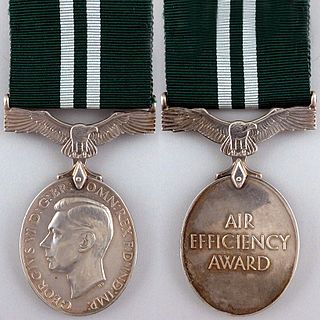
The Air Efficiency Award, post-nominal letters AE for officers, was instituted in 1942. It could be awarded after ten years of meritorious service to officers, airmen and airwomen in the Auxiliary and Volunteer Air Forces of the United Kingdom and the Territorial Air Forces and Air Force Reserves of the Dominions, the Indian Empire, Burma, the Colonies and Protectorates.
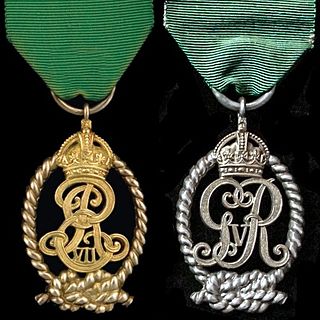
The Decoration for Officers of the Royal Naval Volunteer Reserve, post-nominal letters VD until c. 1947 and VRD thereafter, was instituted in 1908. It could be awarded to part-time commissioned officers in the United Kingdom's Royal Naval Volunteer Reserve after twenty years of service as efficient and thoroughly capable officers. The decoration was a Naval version of the Volunteer Officers' Decoration and its successor, the Territorial Decoration.
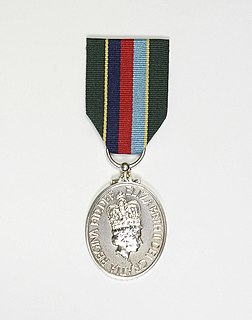
The Volunteer Reserves Service Medal (VRSM) is a medal which may be awarded to members of the Volunteer Reserves of all branches of the British Armed Forces - the Royal Naval Reserve, the Royal Marines Reserve, the Army Reserve and the Royal Auxiliary Air Force. It replaced the separate decorations and medals awarded respectively to officers and other ranks in each of the services - the Royal Navy's Reserve Decoration and Reserve Long Service and Good Conduct Medal, the British Army's Territorial Decoration and Efficiency Medal, and the Royal Air Force's Air Efficiency Award - from 1 April 1999.
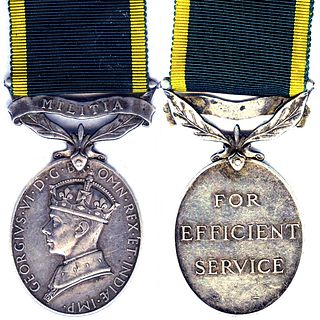
The Efficiency Medal was instituted in 1930 for award to part-time warrant officers, non-commissioned officers and men after twelve years of efficient service on the active list of the Militia or the Territorial Army of the United Kingdom, or of the other Auxiliary Military Forces throughout the British Empire. At the same time a clasp was instituted for award to holders of the medal upon completion of further periods of six years of efficient service.

The Meritorious Service Medal (MSM) is a British medal awarded to sergeants and warrant officers of the British armed forces for long and meritorious service. From 1916 to 1928, eligibility was extended to cover both valuable services by selected other ranks irrespective of length of service, and for gallantry not in the face of the enemy.
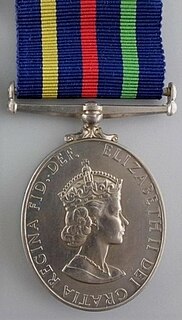
The Civil Defence Medal (CDM) is a long service award by the United Kingdom, instituted by Queen Elizabeth II in March 1961 and awarded for 15 years continuous service in a variety of different organisations including the Civil Defence Corps (CD), the Auxiliary Fire Service (AFS), the National Hospital Service Reserve (NHSR) and the United Kingdom Warning and Monitoring Organisation. Qualification was extended in 1963 to Civil Defence personnel in Gibraltar, Hong Kong and Malta.

The Efficiency Medal was instituted in 1930 for award to part-time warrant officers, non-commissioned officers and men after twelve years of efficient service on the active list of the Citizen Force of the Union of South Africa. At the same time, a clasp was instituted for award to holders of the medal upon completion of further periods of six years of efficient service. The medal superseded the Colonial Auxiliary Forces Long Service Medal.
The Long Service and Good Conduct Medal is a military award recognizing 15 years of exemplary and unblemished service by non-commissioned and other ranks members of the New Zealand Defence Force. Established in 1985, these medals replaced the British Long Service and Good Conduct Medals with specific versions for New Zealand. There are three version of the Long Service and Good Conduct Medal, one each for the New Zealand Army, Royal New Zealand Navy, and the Royal New Zealand Air Force.
The Hong Kong Disciplined Services Medal was a long service medal awarded to members of the Hong Kong Disciplined Services in British Hong Kong. Established by Royal Warrant 8 July 1986, the award of the medal was intended to replace the awarding of the Imperial Service Medal. This medal was replaced by both the Hong Kong Customs & Excise Long Service Medal and the Hong Kong Immigration Service Long Service Medal, for long service to members of the respective disciplined services, upon the transfer of sovereignty in 1997, however the same ribbon continues to be used for the Hong Kong Immigration Service Long Service Medal.

The Royal Naval Volunteer Reserve Long Service and Good Conduct Medal, initially designated the Royal Naval Volunteer Reserve Long Service Medal, was instituted in 1908. It could be awarded to part-time ratings in the United Kingdom's Royal Naval Volunteer Reserve after twelve years of service and good conduct. The medal was a Naval version of the Volunteer Long Service Medal and its successor, the Territorial Force Efficiency Medal.
The Ulster Defence Regiment Medal is a long service medal awarded to part-time members of the Ulster Defence Regiment. Established in 1982, the medal was awarded for 12 years of long and efficient service, with a bar being awarded for each subsequent six years of qualifying service. Officers awarded the medal were entitled to use the post-nominal UD. The medal was replaced by the Northern Ireland Home Service Medal in 1992. Full-time members of the Ulster Defence Regiment were eligible for the Medal for Long Service and Good Conduct after 15 years of service.
The Northern Ireland Home Service Medal is a long service medal awarded to members of the Ulster Defence Regiment and its successor the Royal Irish Regiment. Established in 1992, the medal is awarded for 12 years of long and efficient service. Clasps are awarded for six subsequent years of qualifying service. The medal replaced the Ulster Defence Regiment Medal.

The Ambulance Service Long Service and Good Conduct Medal is a long service medal of the United Kingdom established in 1995. The medal is awarded to recognise long service by all clinical grades of the ambulance services who serve on emergency duty.
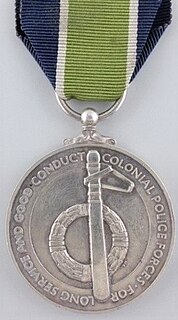
The Colonial Police Long Service Medal was established in 1934 to recognise long service in the police forces of the colonies and overseas territories of the United Kingdom. On 10 April 2012 the medal became known as the Overseas Territories Police Long Service Medal.

The Colonial Prison Service Medal was established on 28 October 1955 as a long service medal of the United Kingdom and the Commonwealth. On 10 April 2012 the medal became known as the Overseas Territories Prison Service Medal, and underwent a minor change in design. This reflected the change in the way Britain's remaining colonies were described, they having been classed as 'Overseas Territories' from 2002.

The Naval Long Service and Good Conduct Medal (1848) is a long service medal awarded to regular members of Her Majesty's Naval Service. It was instituted by Queen Victoria to replace the Naval Long Service and Good Conduct Medal (1830), and could be awarded to other ranks and men serving in the Royal Navy and Royal Marines. Since 2016, after a number of changes in eligibility, all regular members of the Royal Navy and Royal Marines who have completed fifteen years of reckonable service can be awarded the medal.

The Colonial Special Constabulary Medal was established on 1 April 1957 as a volunteer and part-time long service medal of the United Kingdom and the Commonwealth. On 10 April 2012 the medal became known as the Overseas Territories Special Constabulary Medal, and underwent a minor change in design. This reflected the change in the way Britain's remaining colonies were described, they being classed as 'Overseas Territories' from 2002.














